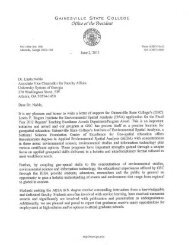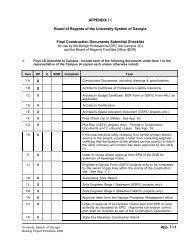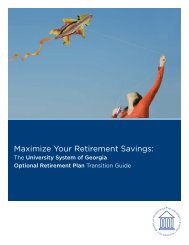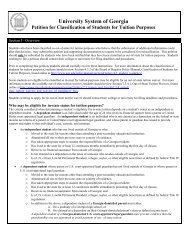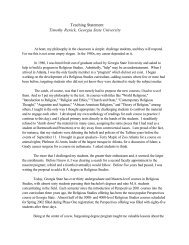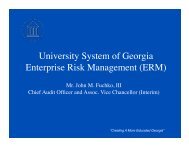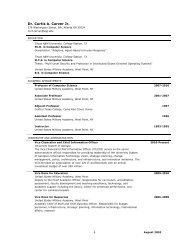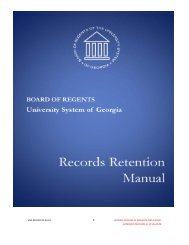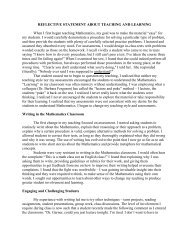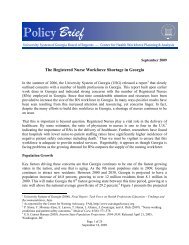66854 Federal Register / Vol. 75, No. 209 / Friday, October 29, 2010 / Rules and RegulationsWReier-Aviles on DSKGBLS3C1PROD with RULES2policy, the agency must promptly notifythe Secretary.One commenter believed that withregard to proposed § 603.24(c)(2), itwould be appropriate for a State agencyto review a sample <strong>of</strong> an institution’scurriculum to determine whether thecredit assignment policies were beingappropriately applied by an institution,but it would not be appropriate for aState agency to employ an unspecifiedsample <strong>of</strong> other institutions todetermine whether the credits awardedfor a particular course or programconformed to commonly acceptedpractice in higher education. Thiscommenter suggested revising proposed§ 603.24(c)(1) to require State agenciesto evaluate an institution’s assignment<strong>of</strong> credit hours based on a comparativestudy <strong>of</strong> similar institutions, and torevise proposed § 603.24(c)(2) to specifythat the agency must sample courseswithin an institution’s program <strong>of</strong> study.Discussion: We do not agree with thecommenters who believed that Stateagencies subject to the recognitioncriteria in 34 CFR part 603 will beconfused by § 603.24(c) or will lack theadministrative resources to meet theserequirements. To be subject to§ 603.24(c), a State agency must be anagency recognized by the Secretaryunder 34 CFR part 603 as a reliableauthority regarding the quality <strong>of</strong> publicpostsecondary vocational education inits State. The only States that currentlyhave recognized State agencies under 34CFR part 603 are New York,Pennsylvania, Oklahoma, and PuertoRico.As with accrediting agencies that arerecognized by the Secretary, we do notbelieve it is necessary to define thespecific methods that State agenciesrecognized by the Secretary should useto evaluate institutions’ processes forassigning credit hours.We believe that § 603.24(c)(4)provides the necessary level <strong>of</strong>specificity with regard to a recognizedState agency’s notification to theSecretary in case <strong>of</strong> institutionalnoncompliance with the credit-hourdefinition in § 600.2.Changes: None.Program Eligibility: Clock-to-Credit-Hour Conversion (§ 668.8)Comment: One commenter questionedwhether it is necessary to have a clockto-credit-hourconversion if a credithour is defined in the regulations andaccrediting agencies are required toreview institutional policies forawarding credits to ensure compliance.Two commenters believed thatproposed §§ 600.2 and 668.8(l) define acredit hour in two different ways andare therefore inconsistent. Thesecommenters believed that it is illogicalto define credit hours for purposes <strong>of</strong>the title IV, HEA programs in differentways depending on whether or not aprogram is subject to the clock-hour-tocredit-hourconversion.Discussion: On October 1, 1990, theSecretary published proposedregulations (55 FR 40148–40150) toestablish standards for clock-to-credithour-conversionfor undergraduatevocational training programs and onJuly 23, 1993, the Secretary publishedfinal regulations (58 FR 39618–39623)based on the public comments. TheSecretary published the regulations toaddress significant abuse in the title IV,HEA programs, citing, for example, a309 clock-hour program that wasconverted to a 27.7 quarter-creditprogram. We believe that the potentialfor such abuse continues to exist andthat § 668.8(k) and (l) continues to beessential to the administrative integrity<strong>of</strong> the title IV, HEA programs. In§ 668.8(l)(2) <strong>of</strong> the final regulations, wehave included consideration by aninstitution’s accrediting agency <strong>of</strong> theinstitution’s policies and procedures,and their implementation, fordetermining credit hours in a program ifan institution seeks to establish anyconversions that are less than theconversion rate specified in§ 668.8(l)(1).Due to the separate conversionformula in new § 668.8(l), programs thatare subject to the clock-to-credit-hourconversion in § 668.8(l) are exemptedfrom using the credit-hour definition in§ 600.2. Therefore, we do not believethere is any inconsistency between thedefinition in § 600.2 and the provisions<strong>of</strong> § 668.8(l).Changes: None.Comment: One commenter asked forclarification regarding whether aninstitution that was recently approvedfor a degree program must wait forstudents to graduate from the programbefore it utilizes the exemption, inproposed § 668.8(k)(1)(ii), from therequirements to perform a clock-tocredit-hourconversion under theprovisions in proposed § 668.8(l) withregard to students in a diploma programin which all credits are fullytransferable to the new degree program.Discussion: Section 668.8(k)(1)(ii)provides that an institution’s shorterlength program is not subject to theconversion formula in § 668.8(l) if eachcourse within the shorter program isacceptable for full credit toward adegree that is <strong>of</strong>fered by the institutionthat requires at least two academic years<strong>of</strong> study. Additionally, under§ 668.8(k)(1)(ii), an institution would beVerDate Mar2010 14:10 Oct 28, 2010 Jkt 223001 PO 00000 Frm 00024 Fmt 4701 Sfmt 4700 E:\FR\FM\29OCR2.SGM 29OCR2required to demonstrate that studentsenroll in, and graduate from, the longerlength degree program. Thus, for arecently approved degree program thatis at least two academic years in length,an institution must use clock hours forits title IV, HEA programs that are fullyaccepted for transfer into the newdegree program until students graduatefrom the new degree program unless theinstitution <strong>of</strong>fers other degree programs,each with graduates, and all thecoursework in the first year <strong>of</strong> theprogram is acceptable for full credittoward one or more <strong>of</strong> these otherdegree programs. After studentsgraduate from the new degree program,the programs at the institutions that arefully accepted for transfer into the newdegree program will qualify under theexception in § 668.8(k)(1)(ii). We believethat it is essential that an institution isable to demonstrate that studentsgraduate from the longer length degreeprogram to ensure that the exceptionprovided in § 668.8(k)(1)(ii) is beingappropriately applied. We note that inan instance where a student is enrolledin a new degree program in which thefirst year <strong>of</strong> study may lead to acertificate or diploma and the secondyear provides an associate’s degree, anystudent in the first year must haveeligibility for title IV, HEA programsdetermined on a clock-hour basis untilstudents graduate from the programwith a degree after completing thesecond year.Changes: None.Comment: Several commenters didnot agree with the provisions inproposed § 668.8(k)(2)(i)(A) and (B),which provide for when a program isrequired to measure student progress inclock hours.Two commenters believed that if aninstitution’s State licensing board oraccrediting agency approve a credentialto be awarded in credit hours, then thatapproval should be sufficient to awardtitle IV, HEA program funds based oncredit hours. These commentersbelieved that the provisions in§ 668.8(k)(2)(i)(A) and (B) create anunnecessary duplication <strong>of</strong> servicesprovided by these approving entities.One commenter believed that thisprovision would be detrimental toinstitutions that have received licensing,accrediting, or Federal approval to usecredit hours because these institutionswould need to convert to clock hours.A few commenters believed thatproposed § 668.8(k)(2)(i)(A) is unclearon the requirement to measure studentprogress in clock hours. Thesecommenters believed that Stateagencies’ disclosure and calculationrequirements may involve clock hours
Federal Register / Vol. 75, No. 209 / Friday, October 29, 2010 / Rules and Regulations66855WReier-Aviles on DSKGBLS3C1PROD with RULES2but do not necessarily require that aninstitution measure student progress inclock hours. These commentersrecommended revising proposed§ 668.8(k)(2)(i)(A) so that an institutionis not required to measure studentprogress in clock hours unless theFederal or State authority requires theinstitution to measure student progressexclusively in clock hours. Onecommenter believed that manyaccrediting agencies and State agenciesrequire institutions to include a clockto-credit-hourconversion rate as part <strong>of</strong>the new program submission process,but it is not the agencies’ intent toconsider these credit-hour programs asclock-hour programs. The commentersuggested adding a provision toproposed § 668.8(k)(2)(i)(A) so that itdoes not apply to institutions that arerequired to include a clock-to-credithourconversion rate in their accreditingagency or State application for a newprogram.One commenter believed thataccrediting agencies’ standards varywith regard to requirements forprograms <strong>of</strong>fering a certain number <strong>of</strong>clock hours in order for a graduate to beeligible to take a certification orlicensure exam and students’requirement to attend the programs’clock hours. This commenter believedthat there should be no requirement fora program to be a clock-hour programunless an accrediting agency specifiesthat students must attend the clockhours to take the certification orlicensure exam.A few commenters believed thatcredit-hour programs are morerecognized by employers andinstitutions. These commenters believedthat it is difficult for students in clockhourprograms to transfer to credit-hourprograms. The commenters alsobelieved that employer-paid oremployer-reimbursed tuition programsare generally administered based oncredit hours.One commenter believed that theproposed clock-to-credit-hourconversion provisions that only usecredit hours were not consistentconcerning States throughout theproposed regulations.Discussion: The provisions in§ 668.8(k)(2)(i)(A) provide that aprogram must be considered a clockhourprogram for title IV, HEA programpurposes if the program is required tomeasure student progress in clock hoursfor Federal or State approval orlicensure. We believe that anyrequirement for a program to bemeasured in clock hours to receiveFederal or State approval or licensure,and any requirement for a graduate tocomplete clock hours to apply forlicensure or authorization to practice anoccupation demonstrates that a programis fundamentally a clock-hour program,regardless <strong>of</strong> whether the program hasreceived Federal, State, or accreditingapproval to <strong>of</strong>fer the program in credithours. As clock-hour programs, theseprograms are required to measurestudent progress in clock hours for titleIV, HEA program purposes. In thesecircumstances where a requirementexists for the program to be measured inclock hours, this becomes thefundamental measure <strong>of</strong> that programfor title IV, HEA program purposes. Thisoutcome is not changed for such aprogram when an institution’s Statelicensing board or accrediting agencyalso allows the institution to award acredential based upon credit hours, orwhen a State licensing board mayrequire that a program be measured inclock hours but the program is approvedby the institution’s accrediting agencyin credit hours. Further, because theinstitution is already required to reportor otherwise establish the underlyingclock hours <strong>of</strong> a program, we do notagree that provisions in§ 668.8(k)(2)(i)(A) and (B) create anunnecessary duplication <strong>of</strong> servicesprovided by these approving entities.We also do not believe that using clockhours for title IV, HEA programpurposes will be detrimental toinstitutions that have received licensing,accrediting, or Federal approval to usecredit hours for academic purposes. Inthe case <strong>of</strong> institutions that are requiredto include a clock-to-credit-hourconversion rate in their accreditingagency or State application for a newprogram, we do not believe thoseaccrediting agency or State requirementswould affect the application <strong>of</strong> theprovisions <strong>of</strong> § 668.8(k)(2)(i)(A) and (B)because the institution is clearlyrequired to establish the clock hours inthe program to receive approval.With regard to the commenters whobelieved that credit-hour programs aremore recognized and accepted byemployers and institutions, there are noprovisions in § 668.8(k) and (l) thatwould prevent a program that must beconsidered a clock-hour program fortitle IV, HEA program purposes fromalso being <strong>of</strong>fered in credit hours foracademic or other purposes. We agreethere was an inconsistency in proposed§ 668.8(l)(2) with State requirements.Proposed § 668.8(l)(2) incorrectlyreferred to an institution’s relevant Statelicensing authority when it should havereferred to an institution’s recognizedState agency for the approval <strong>of</strong> publicpostsecondary vocational institutionsVerDate Mar2010 14:10 Oct 28, 2010 Jkt 223001 PO 00000 Frm 00025 Fmt 4701 Sfmt 4700 E:\FR\FM\29OCR2.SGM 29OCR2that approves the institution in lieu <strong>of</strong>accreditation by a nationally recognizedaccrediting agency. This has beencorrected.Changes: Section 668.8(l)(2) has beenmodified to remove the reference fromproposed § 668.8(l)(2) to an institution’srelevant State licensing authority andnow refers to an institution’s recognizedState agency for the approval <strong>of</strong> publicpostsecondary vocational institutions.Comment: Several commenters didnot agree with proposed§ 668.8(k)(2)(iii) that provides that aninstitution must require attendance inthe clock hours that are the basis forcredit hours awarded, except asprovided in current § 668.4(e).Some <strong>of</strong> these commenters questionedthe effect this provision would have oninstitutions’ attendance policies andasked that the <strong>Department</strong> clarifywhether institutions are required to takeattendance and have attendance policiesthat prohibit students from havingabsences. Two commenters believedthat institutions would be required totake attendance in clock hours andcredit hours. A few commenters notedthat institutions that recently convertedto systems using credit hours instead <strong>of</strong>clock hours, but that do not takeattendance, would be particularlyburdened.A few commenters believed that the<strong>Department</strong> did not address howinstitutions should handle typicalclassroom absences or extended leaves<strong>of</strong> absence when calculating clock hourscompleted or converting credit hours toclock hours. One commenter expressedconcern that this provision in proposed§ 668.8(k)(2)(iii) would decreaseinstitutions’ ability to address students’needs in regard to absences. A fewcommenters asked whether a studentmust attend 100 percent <strong>of</strong> the clockhours in a course in order to receivecredit for the course.One commenter believed that theproposed provision is impracticalbecause most institutions use a 50-minute instructional hour instead <strong>of</strong> a60-minute clock hour. This commenteralso believed that the provision wasunclear on whether the relevant clockhours would be considered to beprovided if no instructor appeared forthe clock hour.One commenter believed that the<strong>Department</strong> should clearly state in thefinal regulations that § 668.8(k)(2)(iii) isnot intended to be a test <strong>of</strong> thereasonable equivalencies thatinstitutions can develop with regard todetermining credit hours as that term isdefined in proposed § 600.2.Discussion: We believe it is essentialfor an institution to require students to
- Page 1 and 2: Friday,October 29, 2010Part IIDepar
- Page 3 and 4: Federal Register / Vol. 75, No. 209
- Page 6 and 7: 66836 Federal Register / Vol. 75, N
- Page 8 and 9: 66838 Federal Register / Vol. 75, N
- Page 10 and 11: WReier-Aviles on DSKGBLS3C1PROD wit
- Page 12 and 13: 66842 Federal Register / Vol. 75, N
- Page 14 and 15: 66844 Federal Register / Vol. 75, N
- Page 16 and 17: WReier-Aviles on DSKGBLS3C1PROD wit
- Page 18 and 19: 66848 Federal Register / Vol. 75, N
- Page 20 and 21: 66850 Federal Register / Vol. 75, N
- Page 22 and 23: WReier-Aviles on DSKGBLS3C1PROD wit
- Page 26 and 27: WReier-Aviles on DSKGBLS3C1PROD wit
- Page 28 and 29: 66858 Federal Register / Vol. 75, N
- Page 30 and 31: 66860 Federal Register / Vol. 75, N
- Page 32 and 33: 66862 Federal Register / Vol. 75, N
- Page 34 and 35: 66864 Federal Register / Vol. 75, N
- Page 36 and 37: 66866 Federal Register / Vol. 75, N
- Page 38 and 39: WReier-Aviles on DSKGBLS3C1PROD wit
- Page 40 and 41: WReier-Aviles on DSKGBLS3C1PROD wit
- Page 42 and 43: 66872 Federal Register / Vol. 75, N
- Page 44 and 45: WReier-Aviles on DSKGBLS3C1PROD wit
- Page 46 and 47: WReier-Aviles on DSKGBLS3C1PROD wit
- Page 48 and 49: WReier-Aviles on DSKGBLS3C1PROD wit
- Page 50 and 51: 66880 Federal Register / Vol. 75, N
- Page 52 and 53: WReier-Aviles on DSKGBLS3C1PROD wit
- Page 54 and 55: 66884 Federal Register / Vol. 75, N
- Page 56 and 57: 66886 Federal Register / Vol. 75, N
- Page 58 and 59: WReier-Aviles on DSKGBLS3C1PROD wit
- Page 60 and 61: WReier-Aviles on DSKGBLS3C1PROD wit
- Page 62 and 63: WReier-Aviles on DSKGBLS3C1PROD wit
- Page 64 and 65: WReier-Aviles on DSKGBLS3C1PROD wit
- Page 66 and 67: WReier-Aviles on DSKGBLS3C1PROD wit
- Page 68 and 69: WReier-Aviles on DSKGBLS3C1PROD wit
- Page 70 and 71: WReier-Aviles on DSKGBLS3C1PROD wit
- Page 72 and 73: 66902 Federal Register / Vol. 75, N
- Page 74 and 75:
WReier-Aviles on DSKGBLS3C1PROD wit
- Page 76 and 77:
WReier-Aviles on DSKGBLS3C1PROD wit
- Page 78 and 79:
66908 Federal Register / Vol. 75, N
- Page 80 and 81:
WReier-Aviles on DSKGBLS3C1PROD wit
- Page 82 and 83:
66912 Federal Register / Vol. 75, N
- Page 84 and 85:
WReier-Aviles on DSKGBLS3C1PROD wit
- Page 86 and 87:
66916 Federal Register / Vol. 75, N
- Page 88 and 89:
WReier-Aviles on DSKGBLS3C1PROD wit
- Page 90 and 91:
WReier-Aviles on DSKGBLS3C1PROD wit
- Page 92 and 93:
WReier-Aviles on DSKGBLS3C1PROD wit
- Page 94 and 95:
66924 Federal Register / Vol. 75, N
- Page 96 and 97:
WReier-Aviles on DSKGBLS3C1PROD wit
- Page 98 and 99:
66928 Federal Register / Vol. 75, N
- Page 100 and 101:
WReier-Aviles on DSKGBLS3C1PROD wit
- Page 102 and 103:
66932 Federal Register / Vol. 75, N
- Page 104 and 105:
WReier-Aviles on DSKGBLS3C1PROD wit
- Page 106 and 107:
66936 Federal Register / Vol. 75, N
- Page 108 and 109:
66938 Federal Register / Vol. 75, N
- Page 110 and 111:
66940 Federal Register / Vol. 75, N
- Page 112 and 113:
66942 Federal Register / Vol. 75, N
- Page 114 and 115:
66944 Federal Register / Vol. 75, N
- Page 116 and 117:
66946 Federal Register / Vol. 75, N
- Page 118 and 119:
WReier-Aviles on DSKGBLS3C1PROD wit
- Page 120 and 121:
WReier-Aviles on DSKGBLS3C1PROD wit
- Page 122 and 123:
WReier-Aviles on DSKGBLS3C1PROD wit
- Page 124 and 125:
66954 Federal Register / Vol. 75, N
- Page 126 and 127:
WReier-Aviles on DSKGBLS3C1PROD wit
- Page 128 and 129:
66958 Federal Register / Vol. 75, N
- Page 130 and 131:
66960 Federal Register / Vol. 75, N
- Page 132 and 133:
WReier-Aviles on DSKGBLS3C1PROD wit
- Page 134 and 135:
WReier-Aviles on DSKGBLS3C1PROD wit
- Page 136 and 137:
WReier-Aviles on DSKGBLS3C1PROD wit
- Page 138 and 139:
66968 Federal Register / Vol. 75, N
- Page 140 and 141:
66970 Federal Register / Vol. 75, N
- Page 142 and 143:
66972 Federal Register / Vol. 75, N
- Page 144 and 145:
66974 Federal Register / Vol. 75, N



